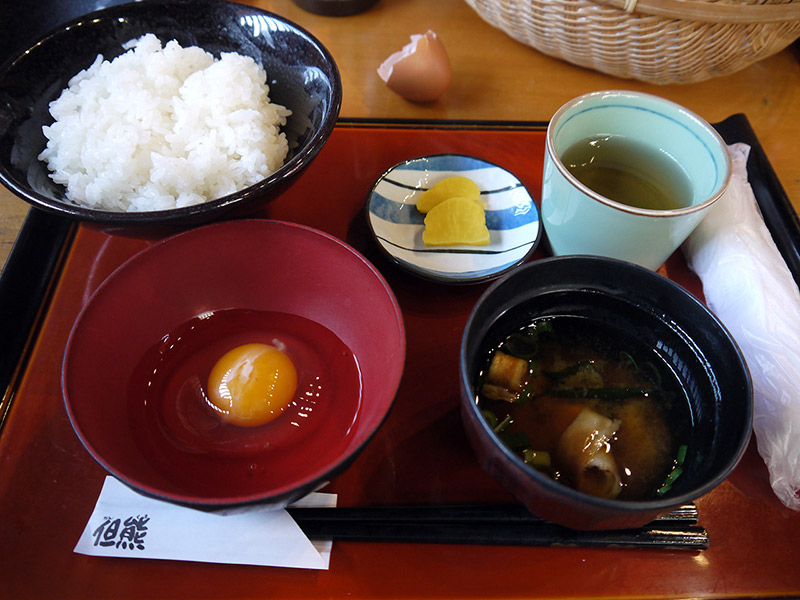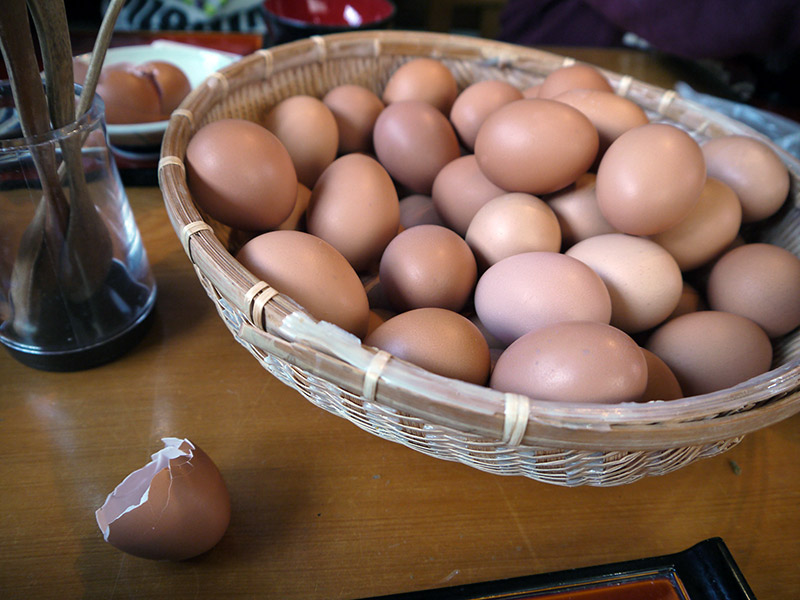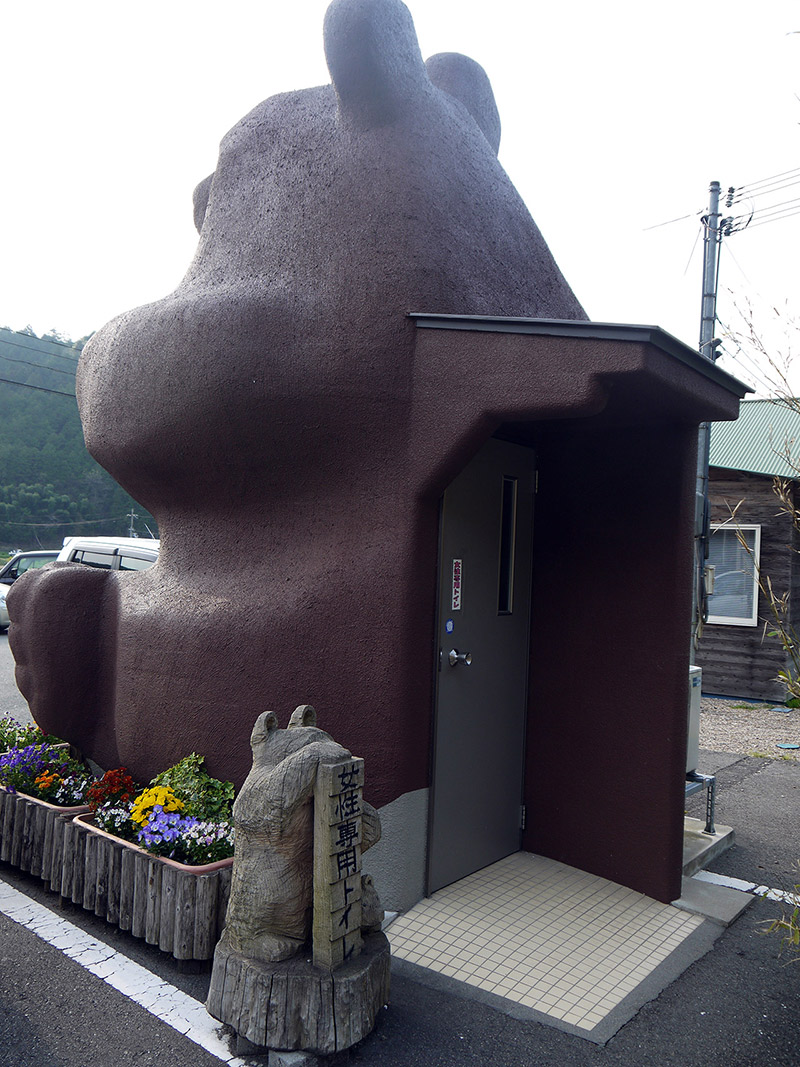What an eggy week it has been! I wrote a travel review of an Egg Vending Machine and a raw-egg-on-rice (tamago-kake-gohan) restaurant called Tankuma. I also wrote simply about the famous Japanese dish tamago kake gohan. I mentioned them a few times, but when I went to Tankuma (the tamago-kake-gohan restaurant) I was both enamored and curious about all the bear statues and figures. I also wanted to know more about the egg vending machine, how this restaurant was started, and more. So, I visited the office of the president of Tankuma, Mr. Gensho Nishigaki (as instructed by his sister, the owner of a nearby pharmacy). He wasn't there at the time, but a worker called to tell him I was there, and he was egg-stremely generous with his time, coming down to his office to answer my questions. So, thank you Mr. Nishigaki! Down below is the story that he told me.
Q. You have four places of business (the egg vending machine, raw egg on rice restaurant, your personal farmer's market shop, and cake shop), but which place did you come up with first?
The vending machine and the veggie shop (personal farmer's market) were first, then the raw egg on rice restaurant, and finally the cake shop.
Q. How did you come up with the vending machine (and the direct store)?

About 40 years ago, there were 18-20 chicken farmers around this area and we were selling our eggs to Osaka and Kyoto together by splitting the transportation costs. However, as other big farmers got ever larger, small farmers like us were getting pushed out. About 20 years ago, I was the only chicken and rice farmer left here. Although I didn't have benefit of a larger scale farm and production, I did have a very unique quality to my eggs. Yet, I still had to decrease employment costs, so I decided to start the vending machine and the direct sales store in 1996. They both went well and the sales of my eggs increased.
Q. Why did you open the tamago-kake-gohan (raw egg and rice) restaurant afterward?

Actually there is a long story to that one. Although the eggs started selling well, selling rice wasn't that easy since there are so many rice farmers in Japan. If I became a member of J.A. (short for Japan Agricultural Cooperatives), I could obtain some money right away, but I didn't want my rice to just be one the many kinds of rice that J.A. sold at the same price because I found my rice to be different. My rice field is located on top of a mountain, so we use only the fresh water that comes from the mountain. It is very clean, pure water, so it makes rice taste better, but it is also so cold that we can't harvest a lot of rice compared to rice fields with access to warmer water. Furthermore, I had to deal with boars and deer eating my rice crops. If my rice was sold at the same price in J.A., it wouldn't be fair. So, I decided to sell my rice by myself, though I also had to take the risk of not getting any money until the rice was actually sold. Moreover, every year I also needed to adjust my rice stock until the following harvest. Every Fall, around September and October, new rice is harvested, so the rice harvested the previous year gets price dropped.
Yet, I couldn't sell it very successfully if it was only available in the direct sale shop, so I thought, "I can't sell uncooked rice, but what if I make delicious cooked rice?" My cooked rice is delicious but I realized that the people I sell the rice to aren't able to taste it the same way that I do. They bring the uncooked rice back to their home towns and put their own city water in their rice cookers. Because of this, they miss the chance to taste the BEST tasting rice that I cook by using the perfect amount of mountain water.
The first item I started was not tamago kake gohan (raw-egg-on-rice), but onigiri (rice balls). My goal was to let people know how tasty the rice was by itself, so I made very simple onigiri and seasoned them with a little bit of salt. Unfortunately, those simple onigiri didn't become that popular. People still bought rice balls, but only if they were seasoned with a lot of ingredients. That killed the taste of the rice itself. I wasn't satisfied with the result.
I was actually thinking of making a raw-egg-on-rice restaurant for a long time, alongside the rice ball business, since I have chicken farms and a rice field. However, whoever I consulted with laughed at me because they thought that nobody would come all the way out to the middle of a mountain for such a simple meal that everybody can just make themselves. So, I didn't even try it out until the huge typhoon (Typhoon #26) struck our region on October 21, 2004.
The river was broken and many places were flooded. Some tourists got stuck on a bus and they had to evacuate to the roof and waited there all night for rescue. In the mountain area, we had a lot of debris scattered everywhere because of the strong flowing water and my farms were damaged. So after the catastrophe, the government subsidized grants to aid farmers. It didn't cover everything to start a new raw-egg-on-rice business, but I thought I could at least try out my idea if I combined this money and my savings. I was really wanting to do this business, so I finally decided to do it, and I opened the restaurant on March 21, 2006.
Luckily, the raw-egg-on-rice boom had just started at that time so my restaurant was interviewed by many media companies, and a lot of people came out to try my raw-egg-on-rice dish. They thought it was tasty and word spread amongst the people until eventually, and thankfully, it became a popular restaurant that people are now lining up for. I've never advertised my restaurant because I thought it would be better for the knowledge of it to spread by word of mouth. I guess I was right about that.
Q: What is the secret of the deliciousness?

As for the eggs, they are all fresh and delivered right from the chicken farm. The name of our eggs is "クリタマ (Kuritama)" because they are produced in Tantouchou-Kurio. We raised the baby chickens from the Goto hatchery in Gifu Prefecture since my father started the chicken farm in 1956. When they grow, they become brown chickens called Gotou-momiji (momiji means Japanese maple leaves). We don't use any antibiotics in their feed (Some people use antibiotics to make the chickens grow faster). As feed, we mix 20 kinds of special feed, such as Super PHF corn, which are not GMO's and are made with very little fertilizer. They don't get fumigated after being harvested, either. We also use fish powder without antioxidants. Those chickens produce delicious eggs on our tranquil mountain farm.
The rice we make is called Yumegokochi 夢ごこち , which means enchantment. It is not organic, but I'm using as little chemical fertilizer as possible. I also use organic fertilizer, which is made from fermented chicken manure. Thus, chicken and rice farming is a great combination! Yumegokochi was invented by the Plant Research Institute as a rice with low amylose and low protein. Only a few places are allowed to make it, so it is a niche market rice with low volume and high prices, being sold to people in the know. It has a great stickiness and the amylose is lower than the king of rice "Koshihikari" by about 2%. It also has a feature which is that it stays soft and tasty even when it gets cold. So you can make rice balls and take it to your work as lunch without losing its deliciousness.
First we use a rice cooker for 1 升/ 1800 cc, which is an old Japanese unit of measurement for liquid, on a gas stove. I was told the best way to cook rice is not to cook it at half capacity, or at full capacity, but at 80% capacity each time. Yet, this typically only serves 8 people, so it was too little after the restaurant became popular. Six months after its opening, we decided to double the amount, which is 80% of 2 升 (3600 cc). It can still serve 15 to 16 people at a time, but I didn't want to increase the amount any more because it might ruin the taste of the rice. And of course we use the delicious pure water from the mountain to cook the rice.
Q. Why are there so many bears here?

Because our restaurant is named Tan-Kuma! Tan comes from the name of this region, Tajima. Kuma, which means bear, got attached because bears come down to our place before winter when they are preparing to hibernate. One day, while on the phone with my friend who I was talking to trying to come up with a name for the restaurant, I looked out the window to see a bear taking some acorns and persimmons from the yard. I told him that and he said "scary", but surprisingly he told me that I should be happy about it. I asked him why and he told me that the bear is the biggest land mammal in Japan, so if a bear is there, that shows you how much nature remains at your place. I was amazed at what he said so I named my restaurant Tankuma – a shorter form of Tajima-no-kuma (Tajima's bear). I wished for a meaning that suggests that people can come to eat delicious food produced in a place with a lot of nature, so much nature, in fact, that you might even see a bear.
Because of the shop's name, my friend, who is also the husband of one of our staff members, named Zigen-san, started making those wooden bears for us. He is a chainsaw artist. You can see his work on his website.
Q. What about the bear bathroom?

The monumental bear bathroom hasn't been there since the beginning. It was made when we built the cake shop in 2010. I created such a toilet because I wanted people to take pictures with it. Everyone takes pictures in front of the restaurant and posts it on their blog or social media sites, but it looks too normal and boring. I thought nobody would usually want to take a photo in front of a toilet, so it would be funny if I made a special toilet that people would want to take pictures in front of. It ended up costing about 3,700,000 yen (~$37,000) and I actually regretted it a little bit afterwards. (chuckle)
Q: Do foreign customers come here too?
It's extremely rare. Our staff can't speak English, either.
Q: Do you have any other new egg business in mind?
Actually no. Now I'm thinking of how to properly pass the baton (the business) on to my daughter and her family. I have to work hard to decrease our debt as much as possible.
Well that's about it. A big thank you to Mr. Gensho Nishigaki for talking with us. We leave you with this amazing Kumaman toilet prototype. We're getting a pattent, so hands off!

